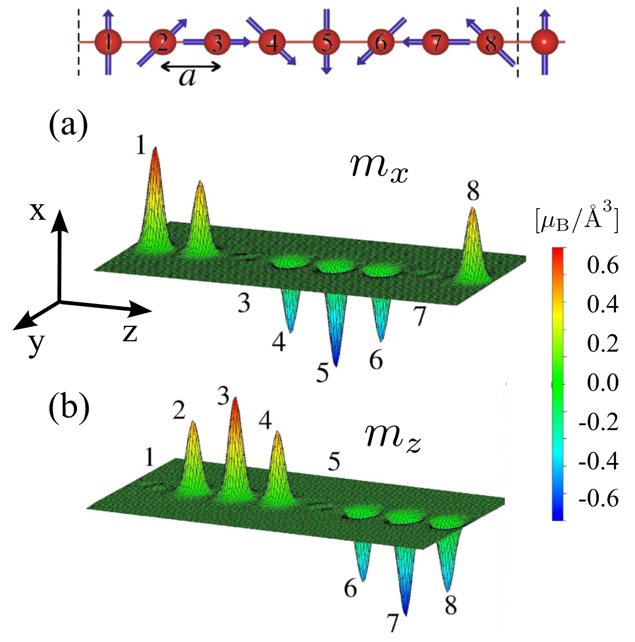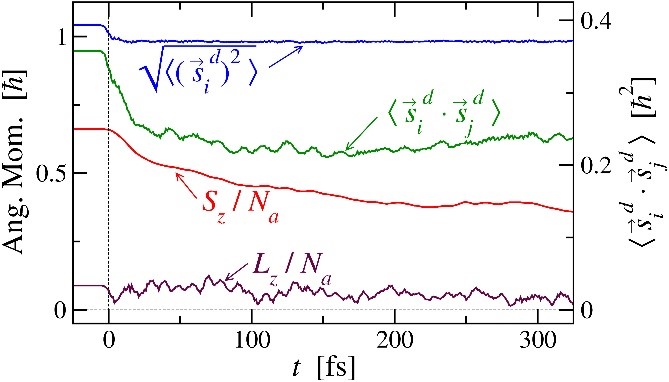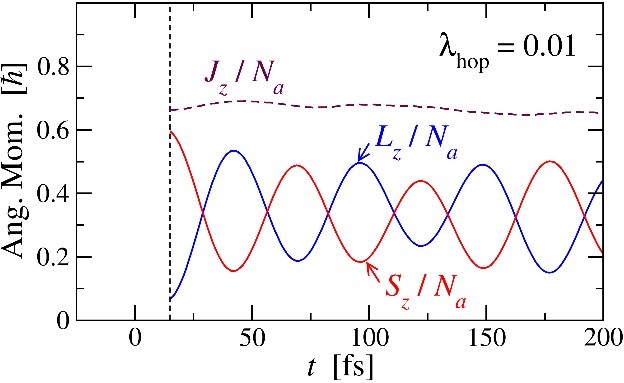Theory of low-dimensional and nanostructured materials
Electronic and magnetic properties of low dimensional transition-metal nanostructures
Text The magnetism of low-dimensional systems remains, despite its long history, one of the most important current challenges in condensed-matter physics. In this work the ground-state electronic and magnetic properties of one-dimensional (1D) 3d transition-metal (TM) nanowires have been investigated in the framework of density-functional theory. The relative stability of collinear and noncollinear (NC) magnetic orders in V, Mn, and Fe monoatomic chains has been quantified by computing the frozen-magnon dispersion relation E(q) as a function of the spin-density-wave vector q. Remarkable spin-density wave (SDW) instabilities have been revealed, which have been shown to be the result of competing ferromagnetic and antiferromagnetic interactions between the local magnetic moments along the chain. As an example, Fig. 1 shows the spin density distribution m(r) = (mx, my, mz) in the stable SDWs found in Fe chains.


A further most interesting discovery is the possibility of reversibly controlling the morphology, orbital magnetism and magnetic anisotropy energy (MAE) of small Co clusters deposited on graphene (G) under the action of an external electric field (EF). A variety of cluster-specific and EF-induced effects are revealed, including (i) perpendicular or canted adsorption configurations of the dimers and trimers, (ii) significant morphology-dependent permanent dipole moments and electric susceptibilities, (iii) EF-induced reversible transitions among the different metastable adsorption morphologies of Fe3 and Co3 on graphene, (iv) qualitative changes in the MAE landscape driven by structural changes, (v) colossal values of the magnetic anisotropy E ≃ 45 meV per atom in Co2/G, (vi) EF-induced spin-reorientation transitions in Co3/G, and (vii) reversibly tunable coercive field and blocking temperatures, which in some cases allow a barrierless magnetization reversal of the cluster. These remarkable electric and magnetic fingerprints open new possibilities of characterizing and exploiting the size- and structural-dependent properties of magnetic nanostructures at surfaces.
References
M. Tanveer, P. Ruiz-Diaz and G. M. Pastor, Phys. Rev. B 94, 094403 (2016).
M. Tanveer, J. Dorantes-Davila and G. M. Pastor, Phys. Rev. B 96, 224413 (2017).
Laser-induced ultrafast demagnetization of transition metals
The ultrafast demagnetization of magnetic transition metals after excitation with short laser pulses has been investigated by considering an electronic many-body model. Exact time propagations for Ni films have revealed the following microscopic mechanism: First, the laser excitations of the valence-electron states open so far Pauli-blocked new channels for spin-orbit coupling induced local angular-momentum transfers from the atomic spins si to the orbital moments li. Then, the perpetual motion of electrons in the lattice due to interatomic hopping quenches most efficiently any incipient increase of the average orbital angular momentum L = Σili on a timescale of the order of only one femtosecond. The result of these simple fundamental processes is the rapid decrease of the average magnetization on a subpicosecond timescale. It has been found that the demagnetized state corresponds to a disordered-local-moment state in which the atomic magnetic moments remain remarkably stable due to strong electronic correlations. Moreover, the calculations have shown that a significant degree of short-range magnetic order persists along the demagnetization process.


References
W. Töws and G. M. Pastor, Phys. Rev. Lett. 115, 217204 (2015).
W. Töws and G. M. Pastor, Phys. Rev. B 100, 024402 (2019).
Prof. Dr. Gustavo Miguel Pastor
full member

- Telephone
- +49 561 804-4780
- pastor[at]uni-kassel[dot]de
- Location
- Universität Kassel
Fachbereich 10 - Naturwissenschaften & Mathematik
Institut für Physik
Heinrich-Plett-Straße 40
34132 Kassel
